2024 Exchange Listing Performance Report: Which of the 9 centralized exchanges has the best online performance?

Reprinted from panewslab
03/09/2025·2MAuthor: Animoca Brands Research
Compiled by: Felix, PANews
This report analyzes more than 3,000 spot token launch events in 2024 between 9 major centralized exchanges (CEXs) and more than 120 decentralized exchanges (DEXs). The purpose is to evaluate the overall trend of tokens on each platform and to evaluate the price and trading volume performance of tokens during these events.
Main discoveries
Centralized exchanges use different strategies to determine the priority of online launches, focusing on different levels of fully diluted valuations (FDV). Exchanges with fewer tokens tend to prioritize tokens with larger FDVs (over $500 million), while exchanges with higher frequency tend to tokens with less than $30 million.
Online activities are closely related to Bitcoin’s price trend, with activity increasing during the bull market and activity decreasing when Bitcoin stagnates. While all tokens of FDV size are affected by this trend, large FDV tokens are more sensitive to changes in market sentiment.
Price performance is measured by the 7- and 30-day changes relative to the end of the price on the online day, reflecting the price trend of Bitcoin to a large extent, but there are indeed differences between different exchanges. A “smile curve” pattern appeared: exchanges with the highest average listed FDV (such as Binance) and lowest (such as MEXC) recorded positive price changes, while medium-sized exchanges (such as Bybit, Bitget) had the biggest declines.
In terms of trading volume, Binance leads in trading volume of newly launched tokens, followed by OKX and Upbit. It is worth noting that Upbit's first 24-hour trading volume is comparable to Binance, while OKX leads in token trading volumes in the FDV rating of $30 million to $100 million.
The first launch of the tokens worth over US$30 million on DEX, with FDV valued at over US$30 million, which is comparable to the first launch of the medium-sized CEX. The price performance of the initial token on DEX (measured by changes from Day 2 to Day 7 and Day 30) is better than that of 4 of the 5 mid-sized CEXs. Trading volumes in the first 30 days are also similar or higher than CEXs such as Kucoin, Gate and MEXC.
It is not uncommon for DEX first-time tokens to appear on medium-sized CEXs later, but it is not common for large CEXs. Among the DEX initial tokens sampled in the second half of 2024, about 16% of the tokens were subsequently launched on CEX, and only 2% of the tokens were successfully launched on large exchanges such as Binance, OKX or Upbit.
CEX online performance
Overview
A total of 3,074 token launch events were recorded in the report. 1226 events (40%) were identified as primary listings and were launched within the first 2 days after the token was released; while 1848 events (60%) were identified as secondary listings.
Most exchanges adopt a balanced approach, and the ratio of participating in primary listing and secondary listing is almost equal.
Generally speaking, exchanges with high FDV projects listed focus on fewer and larger-scale launches, while exchanges with smaller FDV projects listed have more currency listing events.
The two Korean exchanges Upbit and Bithumb focus mainly on secondary listings, which may not be the first time they have been launched due to the practices of these exchanges. For the rest of this article, exchanges will be sorted by their average listing FDV, with exchanges with high listing FDVs called "large exchanges" and the rest called "medium exchanges".
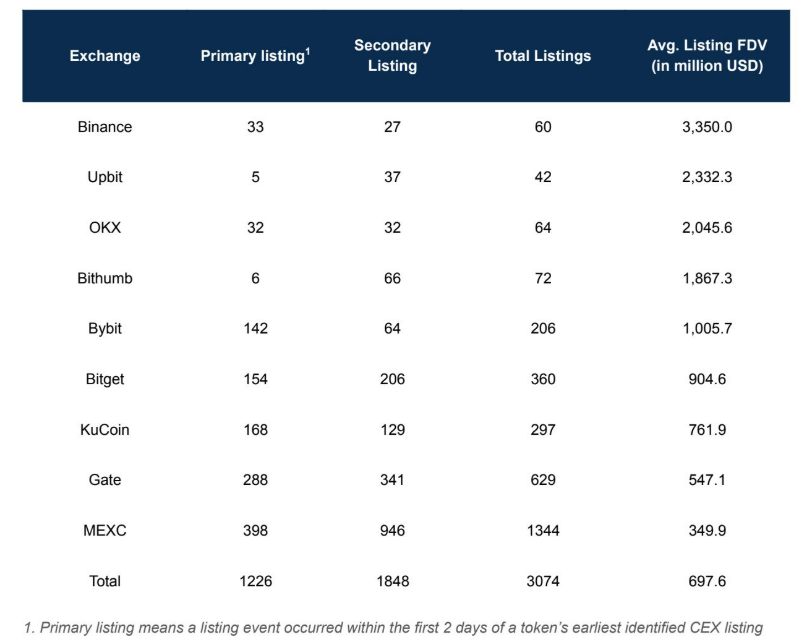
Monthly summary of currency listing events
During the bull market (February to March and August to December), there were many currency listing events, while during the market downturn, the number of currency listing events decreased.
April was a prominent month, and despite the reversal of BTC prices, the listing incident continued to rise. This effect was not obvious in December, when BTC once again stagnated after two months of gains.
In terms of the number of listed events, top exchanges are less affected by the bear market, which is reflected in the continuous expansion of the share of listed events during these periods.
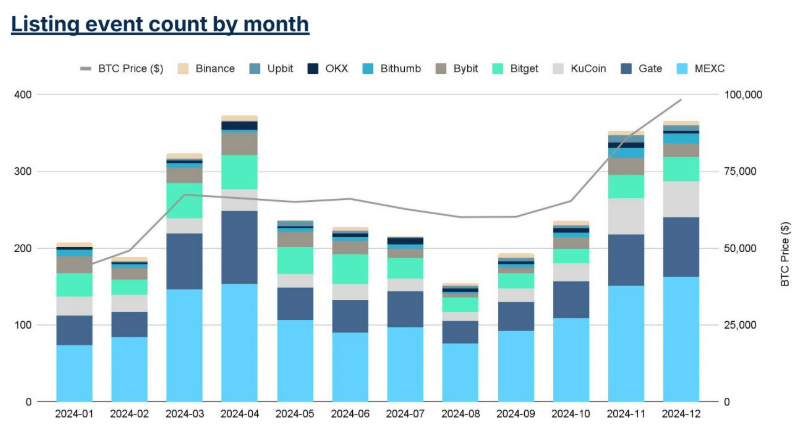
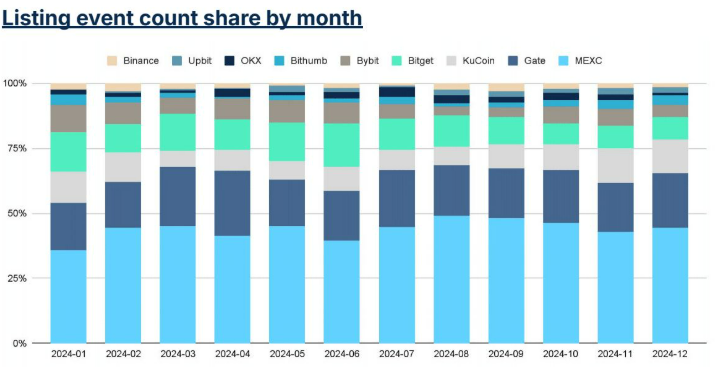
Summarize currency listing events by FDV
Large exchanges focus most of their listing efforts on the FDV category above $500 million, with the top four major exchanges accounting for 25% of the listing activity at this level.
Still, mid-sized exchanges contributed most to the listing activity in the US$500 million category, which may be because projects on large exchanges usually share currency on medium-sized exchanges, but vice versa is not common.
Medium-sized exchanges such as Bybit, KuCoin, Bitget and Gate have a more balanced currency listing at the four FDV levels, with a slightly larger share of between $30 million and $500 million. MEXC has adopted a different strategy, focusing on tokens with FDV ≤ USD 30 million, accounting for 70% of the currency activity in this category.
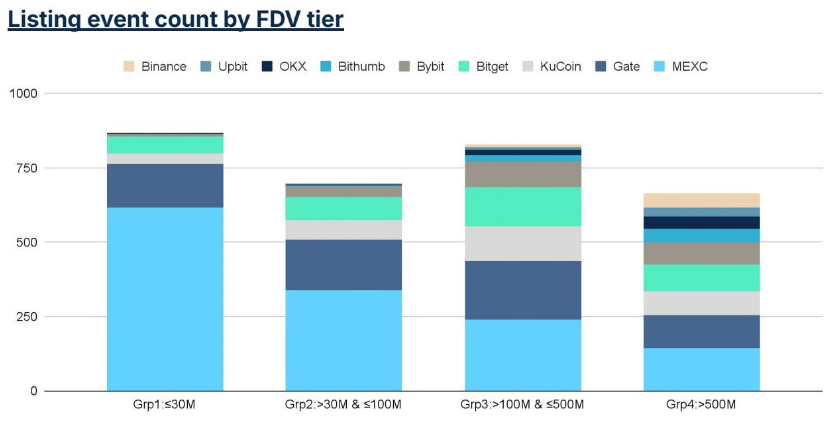
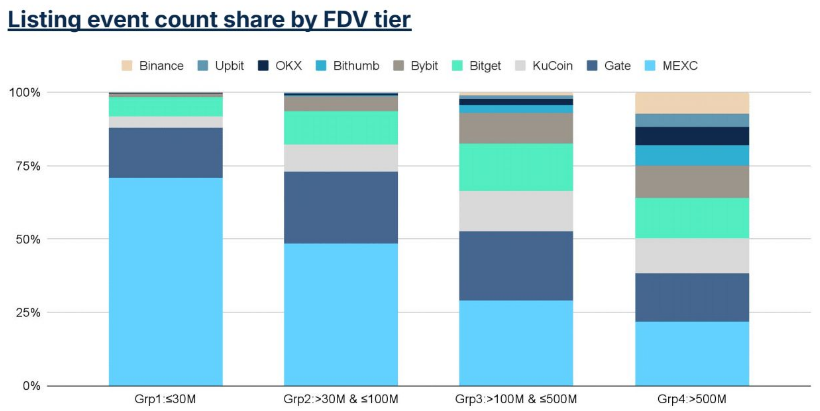
Monthly currency listing events divided by FDV level
The FDV hierarchy above $500 million is most vulnerable to changes in market sentiment, with a rapid increase in currency listings during the February-March rebound, surpassing expectations in April and then contracting until the September-December rebound.
The FDV hierarchy of ≤30 million closely tracks the overall currency trend during the bull market, but accounts for a larger share of currency events during the June-September period.
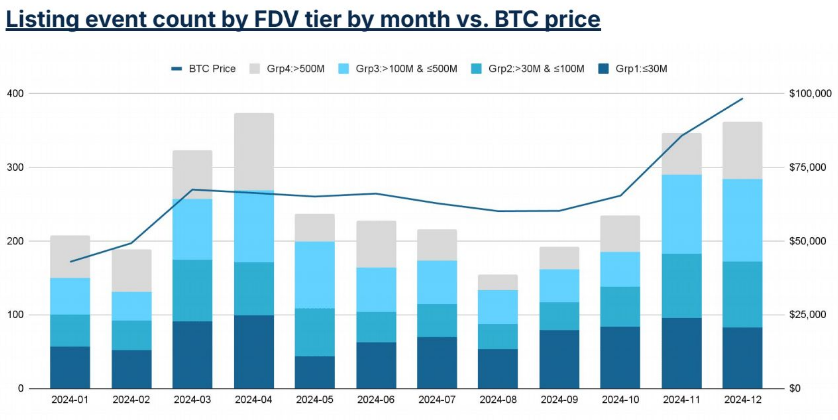
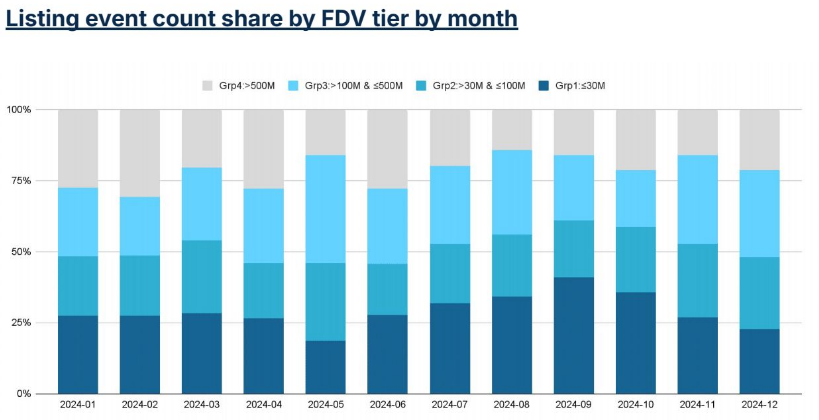
Listing price performance
The price performance of each exchange forms a "smile curve", and the tokens at both ends of the curve perform better than the tokens in the middle.
The tokens launched on Binance and MEXC on both ends showed positive prices after 30 days, while the average price of Bybit and Bitget launched fell by about 10%.
The price performance showed a similar pattern in the 7-day period. Binance's listing rose by about 3%, MEXC's listing remained basically the same, and the decline of the intermediate exchanges was relatively large.
The median price change is usually below average, indicating that a small percentage of token listing events account for the majority of the share.
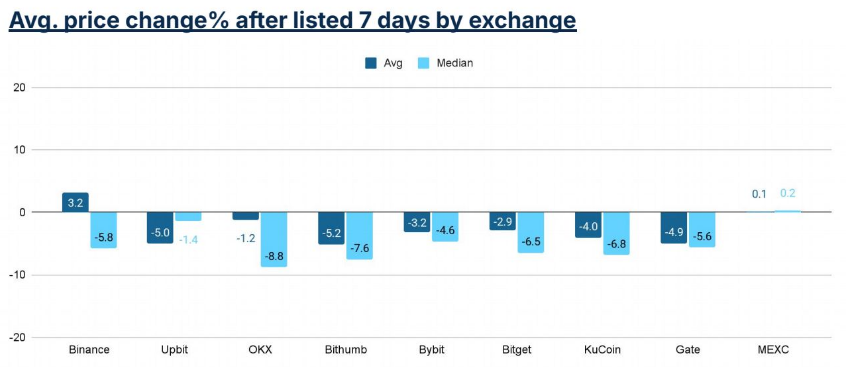
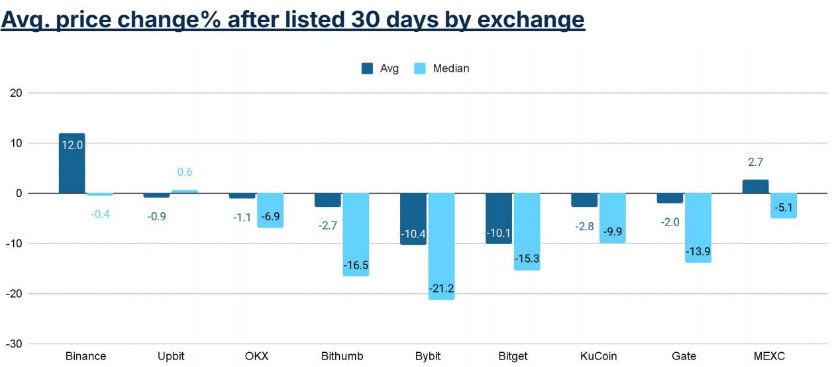
Summary of price performance according to FDV level
According to FDV grade, the price change patterns vary for 7 and 30 days.
The ≤$30 million FDV-grade tokens fell after 7 days, but rebounded strongly by day 30, showing the biggest contrast among the four levels. The price of $300 billion-$100 million and >500 million of FDV grades fell slightly after 7 days, and on average, maintained similar levels over 30 days.
The FDV-rated tokens of $100 million to $500 million fell 2% in the first seven days, but the decline expanded to more than 11% on the 30th day, indicating an overall downward trend after the first week.
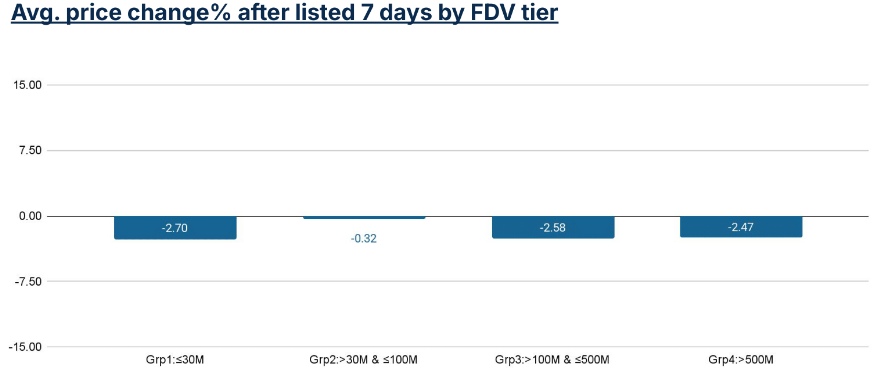
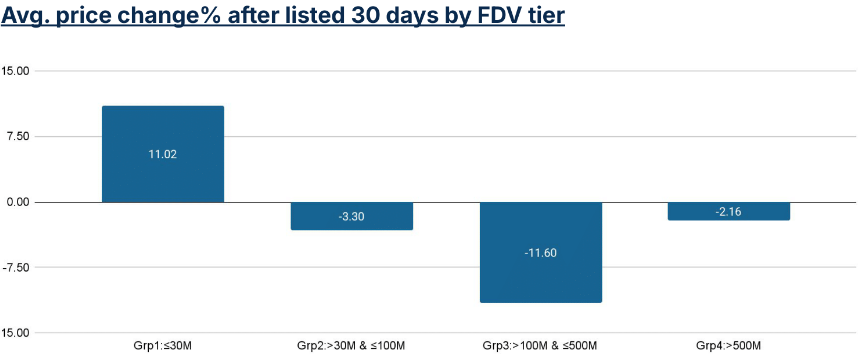
Monthly summary of listed currency price performance
From a time perspective, price performance is mainly driven by market conditions. During the BTC bull market, the token listing performance was neutral or positive. During the BTC bear market, the token listing performed negatively.
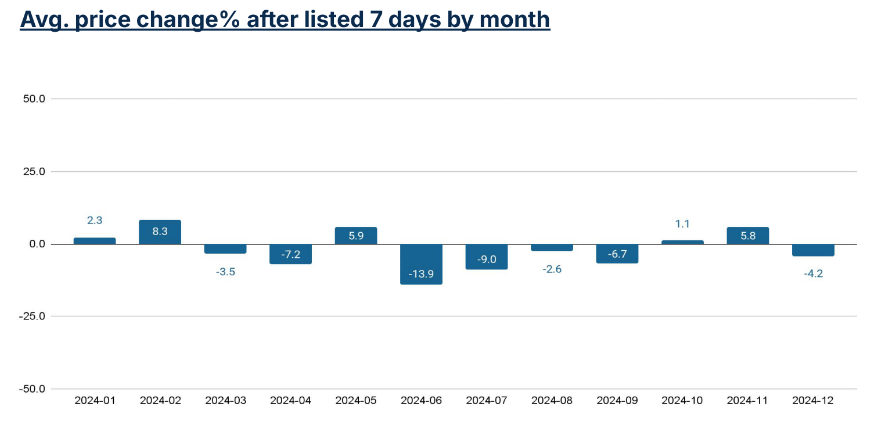
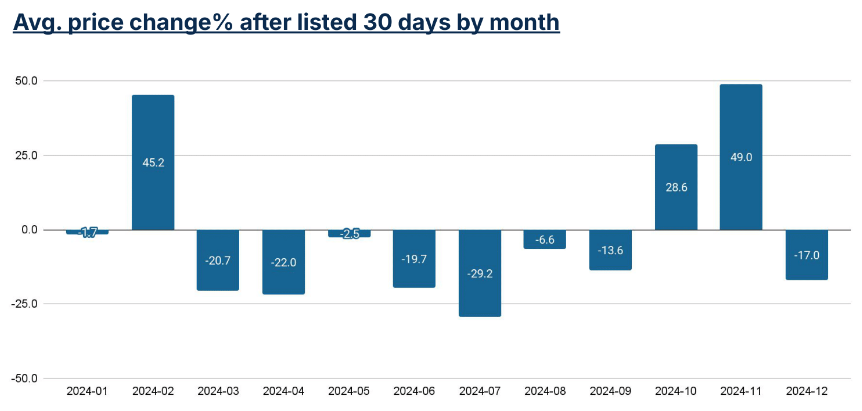
Monthly performance of currency listing prices on each exchange
Price changes on most exchanges remain positive in February, October and November, when BTC prices rose sharply.
January and May have a deviation from the overall BTC price trend: Although BTC is about to rebound, the tokens that went online in January performed poorly; despite May's slow bear market, the tokens that went public performed well.
Despite the neutrality of the market, the tokens listed in December performed poorly.
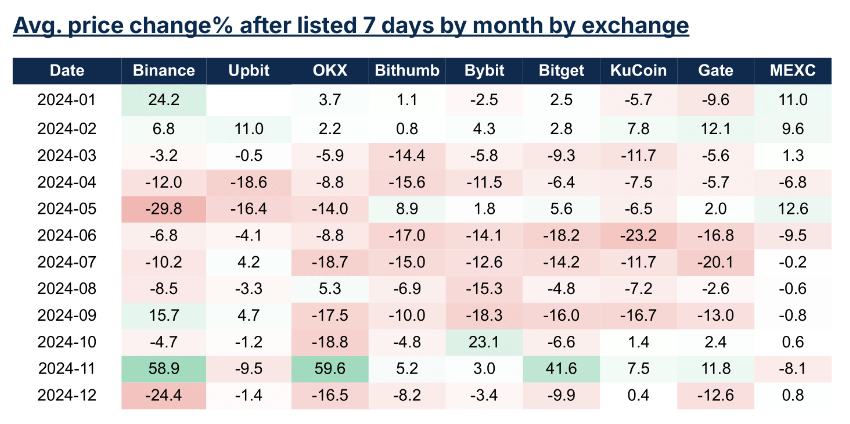
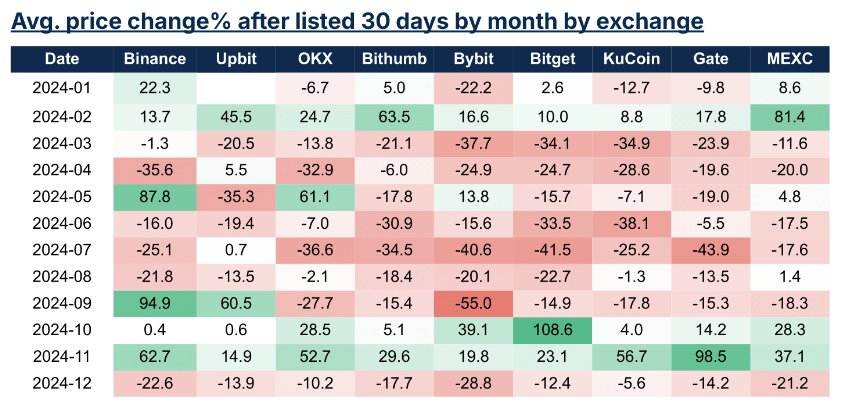
Each exchange **summarizes the performance of listed currency
prices** according to FDV levels
Small FDV token listing activity performs better on mid-sized exchanges such as KuCoin, Gate and MEXC compared to large exchanges such as OKX and Bybit.
The mid-sized FDV token ($30 million to $500 million) listing activity outperforms the mid-sized exchanges on large exchanges. Large FDV tokens (>$500 million) listing activity performed relatively consistently across exchanges, with little price fluctuations from day 7 to day 30.
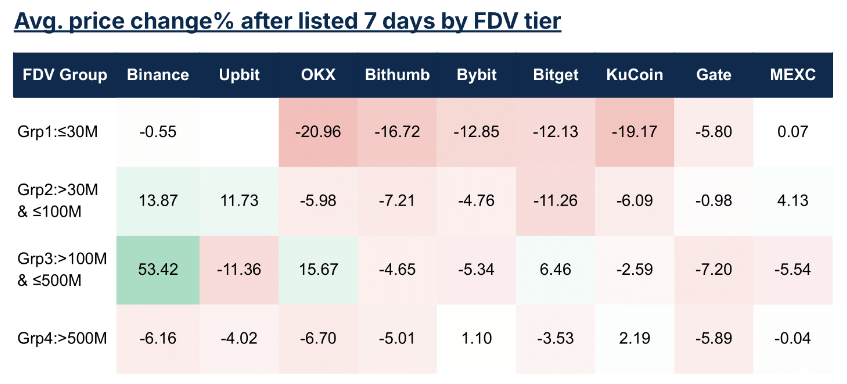
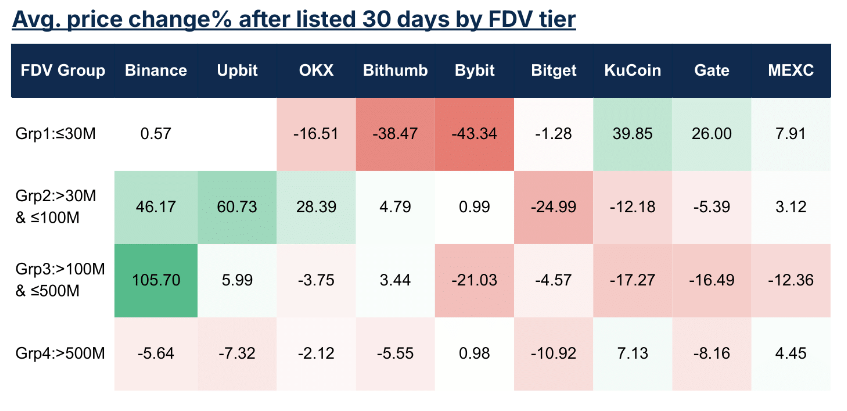
Monthly performance of listed currency prices by FDV level
Small FDV tokens show strong price performance, and in most months, its 30-day price change rate is better than medium FDV tokens ($30 million to $500 million) regardless of whether the market conditions are bull or bear markets.
The mid-sized FDV token experienced strong 7-day price gains in October and November, but still lags behind other categories at 30 days.
Large FDV tokens showed stronger consistency in a few months, with 7- and 30-day prices in half of the months being positive.
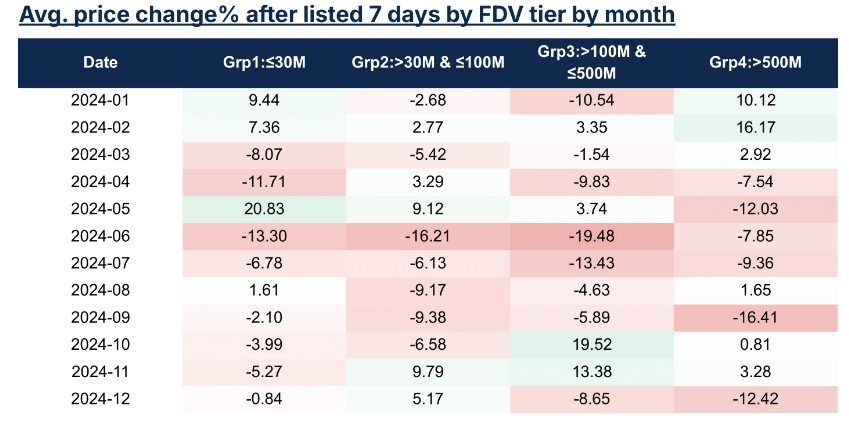
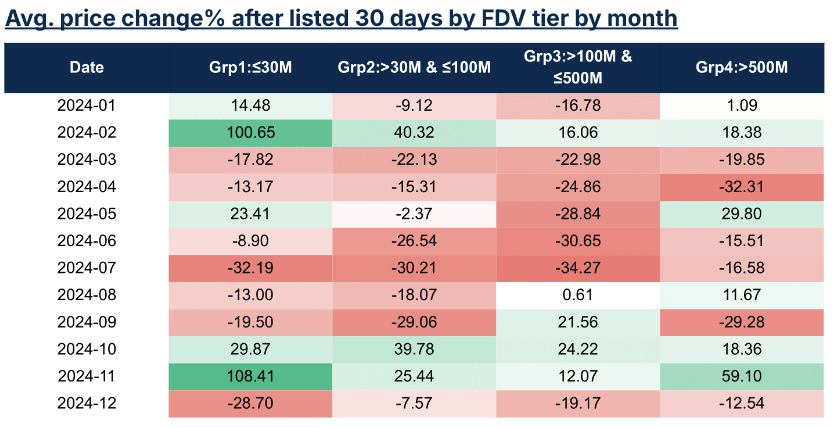
Exchange trading volume
Binance leads in the new token trading volume, followed by Upbit and OKX. Upbit's first 24 hours of trading volume was strong, almost the same as Binance, but the 30-day trading volume fell back to similar levels to OKX.
On the mid-sized exchange, Bybit performed strongly in the first 24 hours and throughout the 30 days.
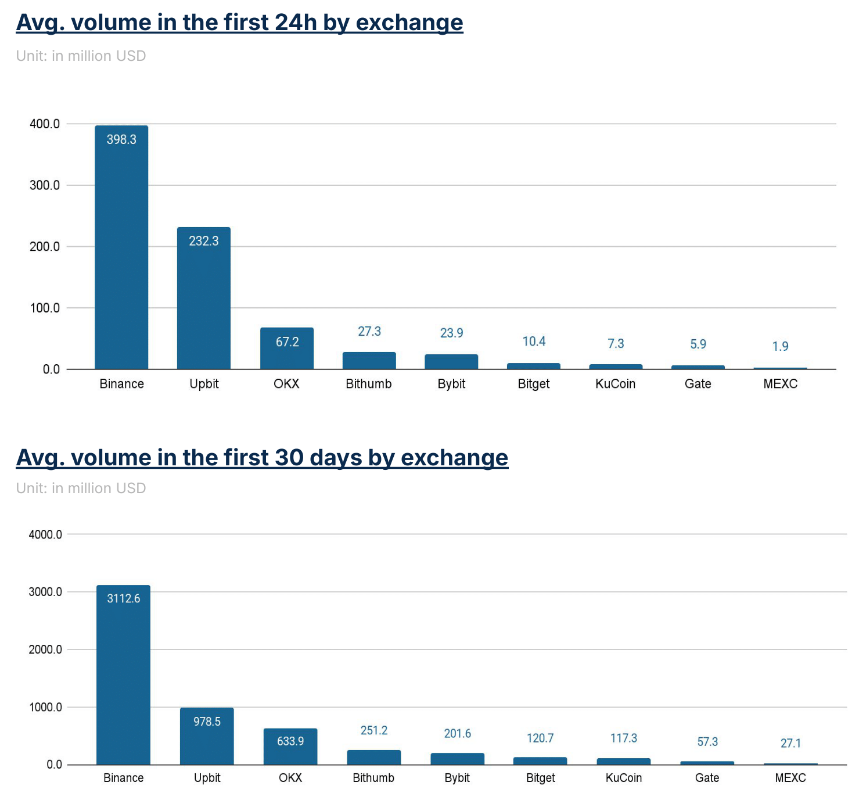
Monthly summary of transaction volume
First-time listing volumes follow a bear/bull cycle to a large extent, with more first-time listing volumes between February and March and September and December.
In April, a month after the first wave of price increases, the listing activity exceeded expectations, but the trading volume was below the 30-day average. This shows that too many coins may dilute the trading volume of newly listed tokens during a relatively calm period.
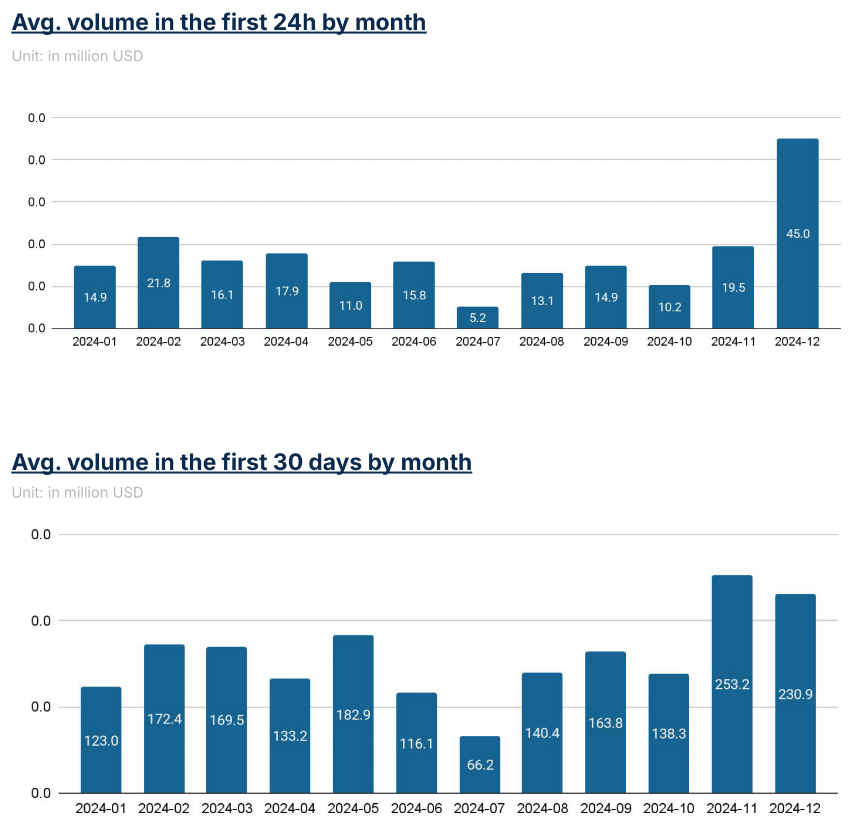
Divide transaction volume by FDV level
Trading volume basically follows the token FDV level. Compared with the minimum FDV level, the maximum FDV level has a trading volume of 60 times the minimum FDV level in the first 24 hours, and 25 times the minimum FDV level in the first 30 days.
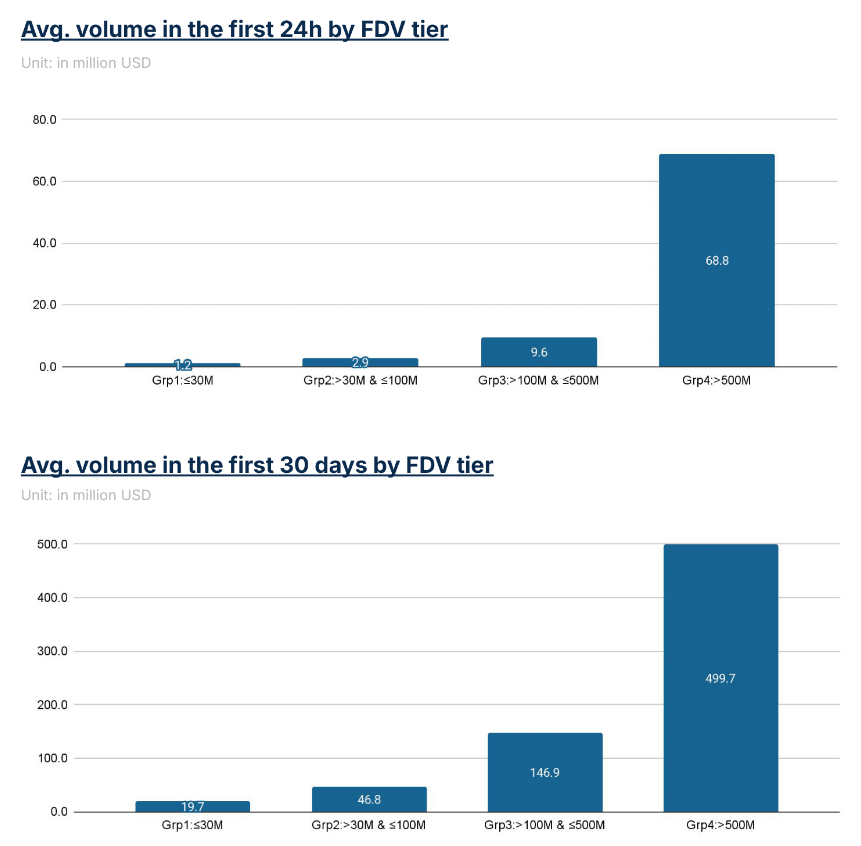
Monthly summary of trading volumes on each exchange
For most months, Binance is leading the way in trading volumes of newly listed tokens. Upbit's newly listed tokens show high uncertainty in initial trading volume.
While it is leading the way in 30-day trading volumes in February, July and December, there have been very low trading volumes in new tokens available in recent months.
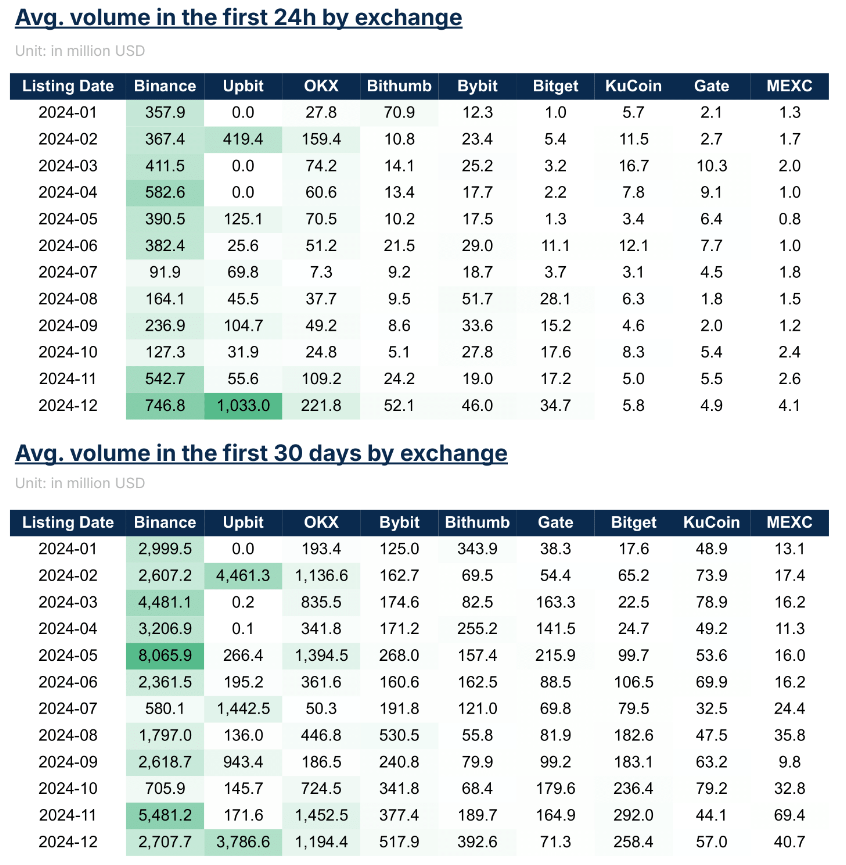
Each exchange divides trading volume according to FDV level
Binance has the largest trading volume, mainly concentrated in the FDV category of $100 million to $500 million.
On the other hand, OKX's intermediate FDV token trading volume is significant (30 million to 100 million US dollars).
Among medium-sized exchanges, Bybit's trading volume in all FDV levels is relatively stable, while other medium-sized exchanges usually focus on intermediate FDV tokens.
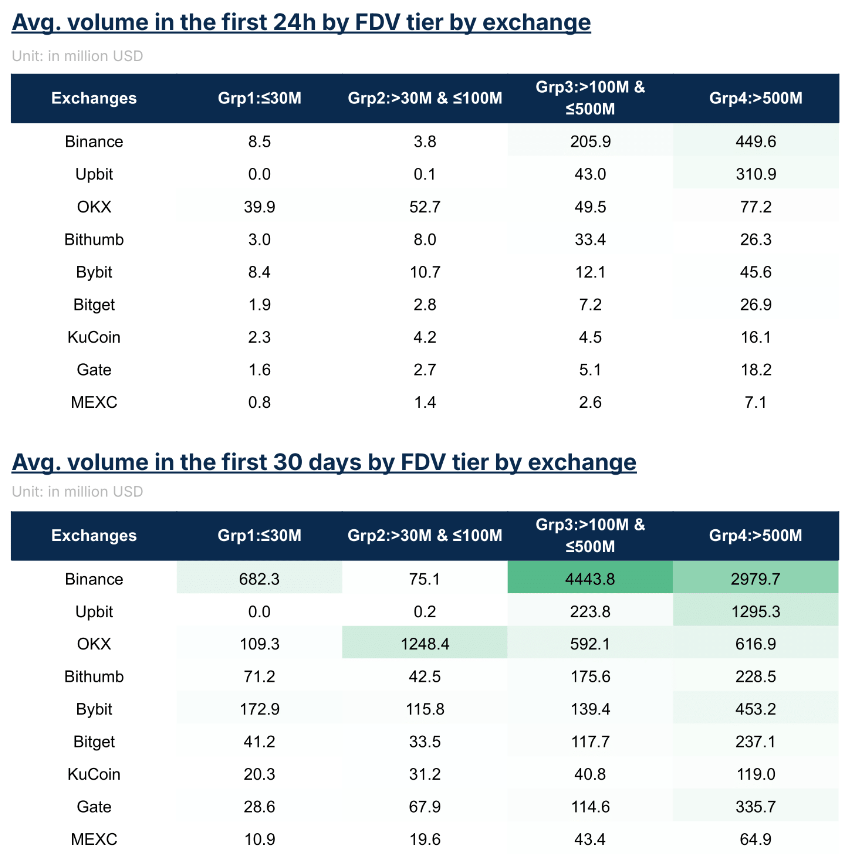
DEX vs CEX
DEX listing is usually regarded as a supplement to CEX listing. The liquidity pool of DEX is usually created at the same time as the initial CEX listing, allowing users to trade flexibly on-chain or through CEX. On the other hand, only DEX is often associated with a more decentralized approach, mainly used by mainstream long-tail tokens with limited attractiveness.
However, more and more projects have recently chosen DEX as its only initial listing platform, postponing or giving up CEX's listing for some time. To evaluate the feasibility and impact of this strategy, relevant data and metrics were analyzed in this paper to compare DEX and CEX.
To ensure objective comparison, DEX listed coins are defined as tokens that exclusively maintain liquidity on decentralized exchanges for at least 30 days. For CEX listing, paying attention to the primary listing event, which represents the introduction of centralized exchanges as its main trading venue tokens. To avoid bias in the results of long-tail tokens, the analysis range is limited to tokens with FDV between USD 30 million and USD 500 million to ensure the balance of the two sets of tokens.
When measuring price performance, use the percentage of price change from day 2 to day 7 and day 2 to day 30 instead of the time period from listing to day 7 or day 30. This adjustment takes into account the different price discovery mechanisms between CEX and DEX on the day of listing, otherwise the direct comparison will be invalid. For volume, a consistent approach uses the first 24 hours and 30 days of trading volume as key indicators.
Listing Event Summary: DEX and CEX
The analysis and sample of 415 major currency listing events occurred in the second half of 2024, focusing on tokens with a fully diluted valuation (FDV) of between $30 million and $500 million. Of these, 114 were classified as priority DEX listing, which means that the tokens were only listed on DEX in the first month.
In August, DEX listings proved a rebound in activity in the fourth quarter after a more sensitive downturn to market momentum. In the third quarter, priority DEX listings accounted for less than 20% of the new tokens, but by November and December, that proportion soared to more than 30%.
Most of the CEX listed coins in this analysis are concentrated on medium-sized exchanges. On the other hand, Binance and OKX only have a few coin listing events.
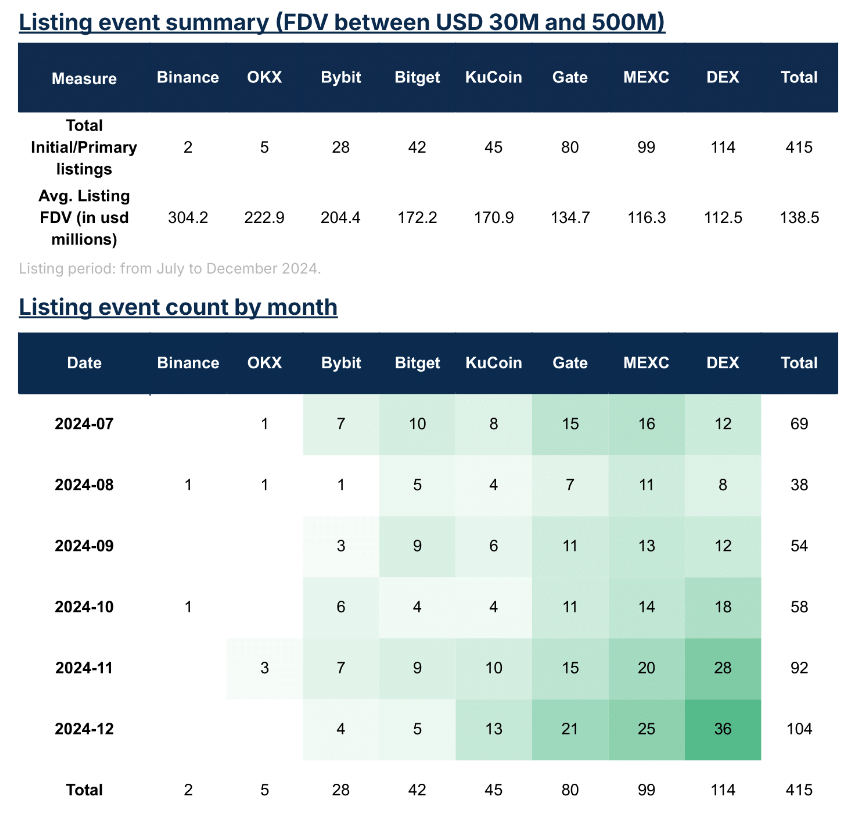
Price changes in DEX and CEX when it first went public
In the mid-sized CEX, the performance from day 2 to day 7 is mixed. By day 30, all listed tokens have negative changes in the price of all listed tokens except those on MEXC.
In contrast, the tokens listed on DEX for the first time showed positive growth on Day 7 and slightly declined on Day 30, outperforming most mid-sized CEX listed tokens.
OKX leads the price performance in large CEXs, with listed tokens up about 14% from day 2 to day 7 and maintaining this level after 30 days. However, due to the limited number of data, the performance of Binance and OKX should be interpreted with caution.
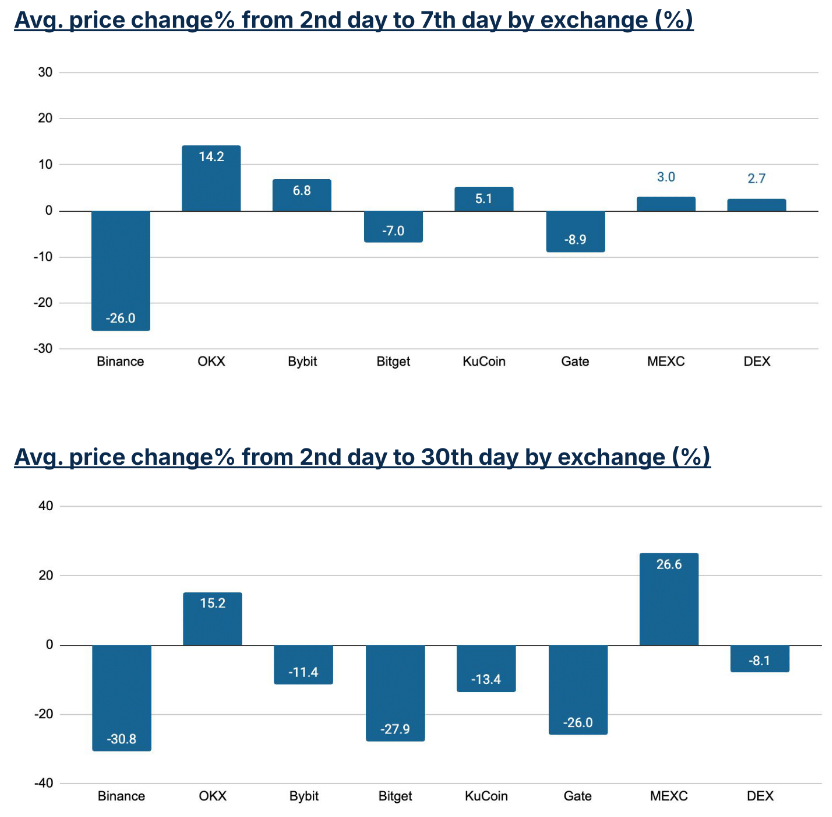
Average trading volume for DEX and CEX first listings
DEX trading volume is comparable to mid-sized CEXs such as KuCoin, Gate and MEXC, with an average trading volume of OKX and Binance higher than other exchanges.
The trading volume concentrations in the first 24 hours of DEX and CEX showed a similar pattern, indicating that the market was concerned about trends.
This volume performance, coupled with the price performance after 30 days of listing, shows that the impact of the initial DEX listing on token performance is comparable to that of medium-sized CEXs.
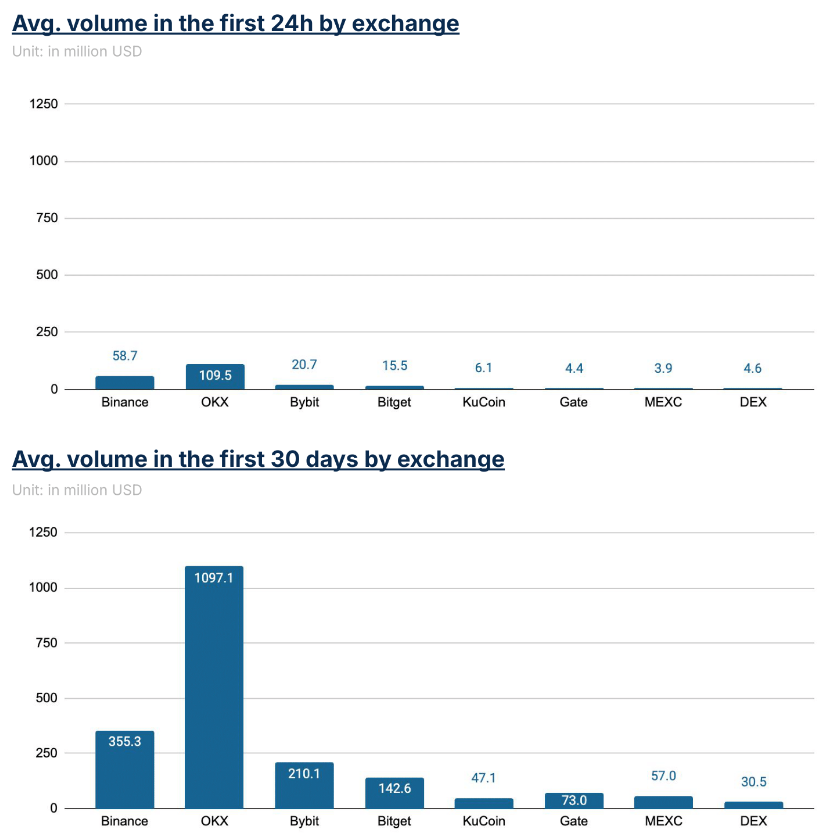
Token listing level analysis
The 415 sampled currency listing events cover a total of 238 tokens. Among them, 126 tokens were initially listed on DEX only, while the remaining tokens were listed on medium or large centralized exchanges. It should be noted that the DEX listed tokens included in the analysis are limited to tokens indexed on CoinMarketCap.
About 16% of the tokens initially listed on DEX were later listed on CEX, mainly in the mid-sized CEX category. However, only 2% of the tokens that start on DEX are then supported on top CEXs such as Binance, Upbit, or OKX. For tokens first on medium-sized CEX, about 3% of them eventually launched high FDV CEX, which is comparable to the tokens for first-selling DEX.
These findings suggest that while priority DEX tokens have considerable opportunities to go public on CEX, they are most likely to be on a medium-sized exchange. Whether the token starts with a DEX or a mid-sized CEX, the possibility of a mid-sized FDV token entering a top-sized CEX remains low.

